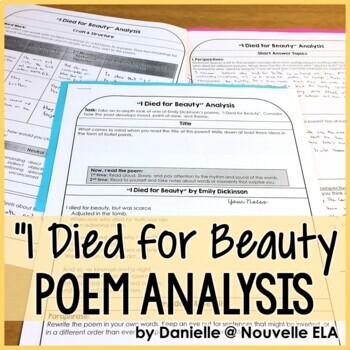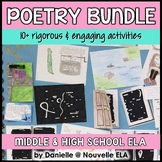Poetry Analysis - Emily Dickinson - Emergency Sub Plan (paper + digital)
- PDF
What educators are saying
Also included in
- These poetry activities are perfect for getting "big kids" to see poetry as fun and engaging! This resource bundle contains handouts, activities, bellringers, and projects for teaching poetry in middle school and high school. Making poetry fun for middle and high school does not mean sacrificing rigPrice $21.99Original Price $32.21Save $10.22
- Are you looking for a fun way to teach poetry during National Poetry Month or any time of year? These middle school poetry activities are just what you need to help students understand and love poetry. Teaching poetry doesn't have to be boring or make you want to tear out your hair.✅ Fully digital pPrice $17.99Original Price $28.72Save $10.73
Description
Are you looking for a poetry analysis lesson students can complete on their own? In this poetry activity, students analyze Emily Dickinson’s “I Died for Beauty.” This scaffolded activity is the perfect sub plan or snow day lesson or during National Poetry Month!
Use this analyzing poetry activity for:
- Independent practice
- Enrichment & Summer School
- Snow Days & Blizzard Bags
- Emergency Plans
Do your students need a skills review?
✅ Use textual evidence to support inferences (RL.7.1)
✅ Determine a central idea and analyze its development (RL.7.2)
✅ Analyze the impact of specific word choice on meaning and tone (RL.7.4)
✅ Determine how a poet develops point of view in the text (RL.7.6)
How do you analyze a poem? Well, this activity breaks it down. Students start by anticipating the theme based on the title. They read the poem two different ways, study key ideas and details, and then dive into craft and structure. Lastly, they answer open-ended short answer questions and write their own poems.
Be sure to check out the preview for a closer look!
What teachers like you are saying…
⭐️⭐️⭐️⭐️⭐️ “My students loved these poems and activities. They want to read more poetry! Thank you.” -Veronica M.
⭐️⭐️⭐️⭐️⭐️ “This is a perfect addition to my poetry unit. I also like that it is a stand-alone resource that can be used by a sub, if needed.” -Karen B.
⭐️⭐️⭐️⭐️⭐️ “Love this for my middle school students! I have several meeting days coming up, and this will be perfect to leave with a substitute. Thank you for including the answer key and rubric!” -Darlene A.
Your Emily Dickinson Poetry Analysis resource includes:
- A Task Page including notetaking and Key Ideas & Details
- A Craft & Structure Page focused on connotation and author’s tone
- Short Answer Topics (assign as many as you want)
- Creative Topic: Response Poem & Self-Evaluation Rubric
- Teacher Rubrics
- Digital Version
While you're here, check out the Independent Writing Activities Bundle and these Collaborative Bellringers!
Feedback & Followers
Did you know that you can receive credit towards future TpT purchases by reviewing this product? If you enjoy this product, please leave a review at the product page or through “My Purchases” under “My Account” at TpT. Ratings make the TpT world go round. :)
You can also follow me for the latest news on products and sales.
If you have any questions, I’d love to hear from you!
-Danielle @ Nouvelle ELA







